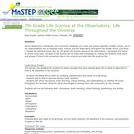
10th grade biology aligned to the standards that is free.
- Subject:
- Life Science
- Material Type:
- Full Course
- Date Added:
- 05/13/2015

10th grade biology aligned to the standards that is free.












This is an extension activity after discussing cancer or lead into discussing about student choices. Essential QuestionsStudents will be able to to describe behaviors lead to skin cancer and how can it be prevented.Students will be able to explain the risk and reward behaviors.

6.5 Nerves, Hormones & Homeostasis | i-Biologyi-biology.net/ibdpbio/06-human-health.../nerves-hormones-homeostasis/Cached
SimilarEssential Biology 6.5 Nerves, Hormones and Homeostasis .........o0O0o. ... Tutorial and game from think-bank ..... Online Learning ... Creative Commons License

In this course, you will learn the principles of genetics with application to the study of biological function at the level of molecules, cells, and multicellular organisms, including humans. We will cover structure and function of genes, chromosomes, and genomes; biological variation resulting from recombination, mutation, and selection; population genetics; and the use of genetic methods to modify genes and genomes and analyze protein function, gene regulation, and inherited disease.
This course, based on the MIT course 7.03 Genetics taken by enrolled MIT students, was organized as a three-part series on edX by MIT’s Department of Biology (Note: The third part of the course is not available yet). It is self-paced and free as long as you enroll in the Audit Track option, which you can select after creating a free account on edX.

In this course, you will engage in the biology of cells of higher organisms. You will study the structure, function, and biosynthesis of cellular membranes and organelles; cell growth and oncogenic transformation; transport, receptors, and cell signaling; the cytoskeleton, the extracellular matrix, and cell movements; cell division and cell cycle; functions of specialized cell types. This course emphasizes the current molecular knowledge of cell biological processes as well as the genetic, biochemical, and other experimental approaches that resulted in these discoveries.
This course, based on the MIT course 7.06 Cell Biology taken by enrolled MIT students, was organized as a three-part series on edX by MIT’s Department of Biology. It is self-paced and free as long as you enroll in the Audit Track option, which you can select after creating a free account on edX.

This course is an in-depth adventure through the molecular mechanisms that control the maintenance, expression, and evolution of prokaryotic and eukaryotic genomes. Through lectures and readings of relevant literature, students will explore gene regulation, DNA replication, genetic recombination, transcription, and mRNA translation. The quizzes are designed to build students’ experimental design and data analysis skills.
This course, based on the MIT course 7.28/7.58 Molecular Biology taken by enrolled MIT students, was organized as a three-part series on edX by MIT’s Department of Biology. It is self-paced and free as long as you enroll in the Audit Track option, which you can select after creating a free account on edX.

This classroom activity will show students that there is a lot we don't know about science, for example life throughout the universe. It will hopefully encourage students to question what we know and don't know, and exploration and study of the unknown.

The coral reefs of the South Pacific island nation of Vanuatu are the backbone of the island's environmental and economic health. Today they face destruction from a silent predator that can rapidly decimate an entire reef. In this video, students learn about how a starfish is destroying the coral reefs of Vanuatu and how the islanders are adapting.

In this video, an entrepreneur is finding new ways to manage the invasive Asian carp problem in the Mississippi and Ohio rivers. Once introduced to help mitigate an algae problem, the carp became invasive. This video highlights how the local community has adapted to the issue, including how they have gained ideas about how to utilize the carp from other cultures to help mitigate the issue.